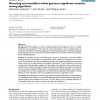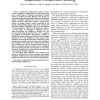214 search results - page 40 / 43 » Perfect and Almost Perfect Sequences |
BMCBI
2007
13 years 7 months ago
2007
Background: Microsatellites are short, tandemly-repeated DNA sequences which are widely distributed among genomes. Their structure, role and evolution can be analyzed based on exh...
BMCBI
2008
13 years 7 months ago
2008
Background: Structure-based computational methods are needed to help identify and characterize protein-protein complexes and their function. For individual proteins, the most succ...
CORR
2010
Springer
13 years 7 months ago
2010
Springer
Compressed sensing allows perfect recovery of sparse signals (or signals sparse in some basis) using only a small number of random measurements. Existing results in compressed sens...
BMCBI
2006
13 years 7 months ago
2006
Background: RNA-dependent gene silencing is becoming a routine tool used in laboratories worldwide. One of the important remaining hurdles in the selection of the target sequence,...
BMCBI
2004
13 years 7 months ago
2004
Background: Many current gene prediction methods use only one model to represent proteincoding regions in a genome, and so are less likely to predict the location of genes that ha...


